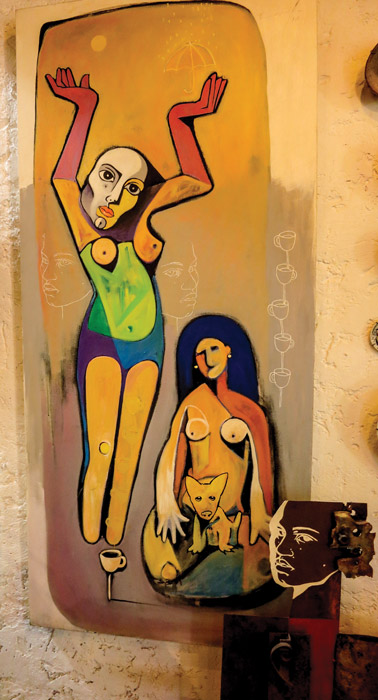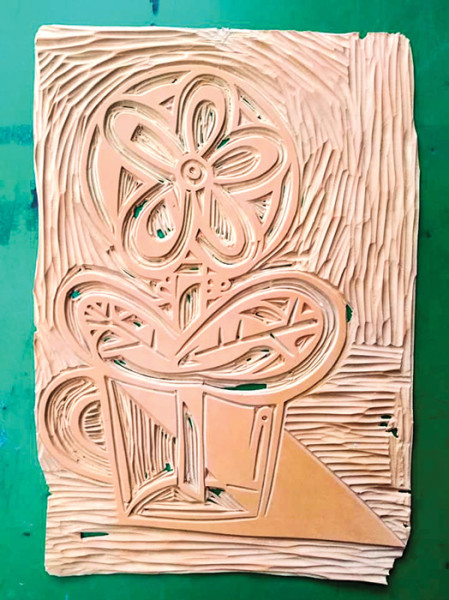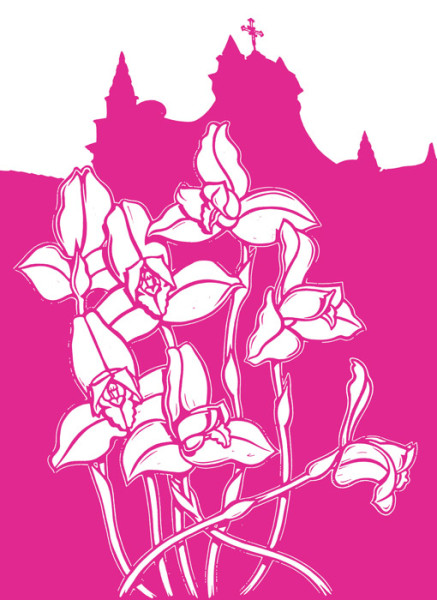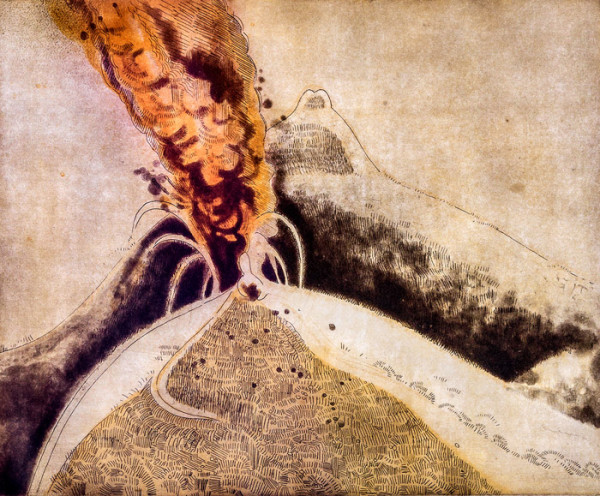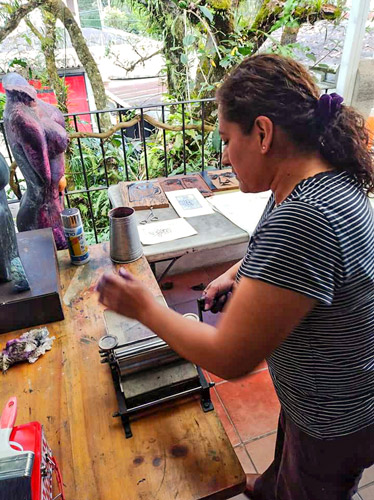Ernesto Argueta Fraatz, Artist Profile
Home is where the art is, an interview with Guatemalan artist Ernesto Argueta Fraatz at his art studio.
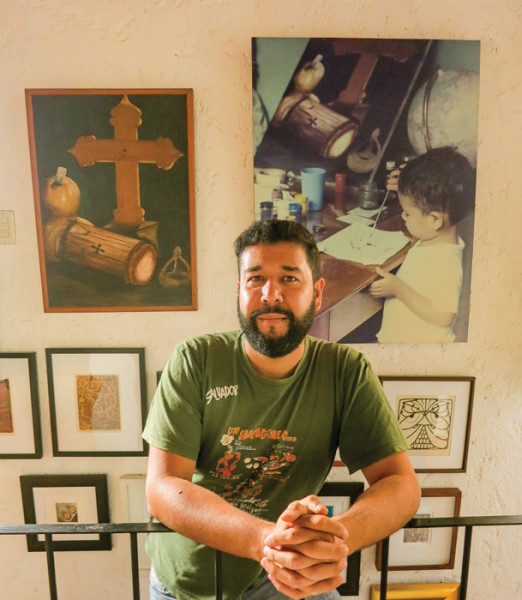
Artist Ernesto Argueta Fraatz in front of photo taken by his father, also an artist, when he was three years old.
It was a beautiful afternoon in early April when I hopped off the bus in San Pedro Carchá, a predominantly Q’eqchi-speaking, Maya municipality located about 10 kilometers east of Cobán in the forested Highlands of Alta Verapaz. I was on my way to meet Guatemalan artist Ernesto Argueta Fraatz at his art studio and home gallery.
I turned a corner and proceeded along a quiet residential street until I noticed a bright red door. At first glance, I wasn’t even sure if I was in the right place, as this did not appear to be your traditional art space. Then I spotted the signature wooden sign with its engraving of an eye, stating simply: Santa Thekla Atelier. “The eye,” explained Ernesto, “signifies poder ver arte,” which translated means “to be able to see art.” I had arrived!
To get to his studio, you must first walk through a magical garden filled with fragrant flora, a gigantic Hass avocado tree that is more than 20 years old and planters overflowing with exotic orchids. For a fleeting moment, I imagined myself in a labyrinth or secret passageway, transported back centuries ago to a mythical and classical Carchá.
It suddenly occurred to me that in the Popol Vuh − the creation story according to the K’iche Maya − there is a narrative about a route to the underworld with a journey that begins in San Pedro Carchá. Certain places, such as caves in and around Cobán, were thought to be entrances to Xib’alb’a, the Maya underworld. In fact, the Xib’alb’a myth originated at the end of the Classic period right here in this region of Alta Verapaz.
Where I was about to enter in 21st century real time, however, was equally alluring. Santa Thekla Atelier is a unique home art gallery and workshop, owned and operated by visual artist, Ernesto Argueta Fraatz, who was born and grew up 50 kilometers east of here in Santa Maria Cahabón. Wherever your wandering eye takes you in this skillfully curated space, you will experience remarkable examples of Guatemalan art, including paintings, photography, stunning sculpture and intricate engraving. The collection also contains an array of playful and unusual contemporary objets d’art clearly meant to intrigue and entertain visitors.
The upstairs level, which displays more amazing art, contains a fully equipped workshop where he teaches his students − the majority of whom come from Cobán, Carchá and the capital − the basic techniques of engraving. Ernesto mentioned that visiting artists from Mexico, El Salvador, Germany and Spain also come to Carchá just to participate in his workshops.
Engraving is clearly this artist’s passion. “As a local artist, I feel it’s my obligation to teach others these techniques,” he said. “Engraving is very versatile with immense possibilities and so many different materials to work and experiment with.” He offers a variety of classes and has been teaching children and adults for more than seven years.
This unassuming and gifted 30-something entrepreneur attended la Escuela Regional de Arte “Alfredo Gálvez Suárez” in Cobán where he studied drawing, painting, sculpture and engraving. In 2008, he was invited to participate in an artist-in-residence program at the Academy of Fine Arts in Nuremberg, Germany, to study art under the tutelage of master artist and Professor Hanns Herpich.
“There are many talented artists in the Alta Verapaz region,” said Ernesto, “but no real museums where we can exhibit our work. With limited community support for visual arts in such a remote part of the country, artists need to take matters into their own hands and do it themselves.”
Seeking out alternative art space has been an emerging trend in many parts of the world over the past few decades. Fierce competition and inaccessible galleries have rendered the home art studio concept an easier way for more artists to garner influence and to create their own destiny.
Home art spaces are generally not money-making endeavors or steppingstones to mainstream galleries. According to Ernesto, they are first and foremost a way for artists to support one another. To that end, Santa Thekla Atelier doesn’t just promote his work but it promotes the work of other Guatemalan artists as well.
“The main reason I have succeeded is because I love art and I like networking with other artists,” said Ernesto. In that spirit, he organized his creative Ropa de Paca exhibit two years ago in which 25 participating artists, all from Alta Verapaz, were asked to send him a sample of their clothing. His intention, explained Ernesto, was to connect with fellow artists by including them all in one unique exhibit and to convey that physical distance is not a barrier. It wasn’t simply about displaying the garments worn by a collection of visual artists but rather to demonstrate the essence, the genius and the imagination that each of the participants brings to the world of art – all under one roof!
A few years ago, he organized an exhibition as homage to renowned Guatemalan artist Nan Cuz, who hails from Senahú, Alta Verapaz. This June and into July, he will be featuring a small sample of the original drawings of Guatemalan master painter and engraver Guillermo Grajeda Mena in celebration of what would be his 100th birthday this year. All of these artistic works are showcased as part of a variety of thought-provoking exhibitions that are offered throughout the year at Santa Thekla Atelier.
In addition to numerous solo exhibitions in Cobán, Salamá, Baja Verapaz and La Antigua Guatemala, Sacatepéquez, many of Ernesto’s works have been featured over the years in collective exhibits throughout Guatemala.
facebook.com/santathekla.atelierdegrabado
More Information about the artist, visit: moving-art.net
REVUE magazine article by Kerstin Sabene.
